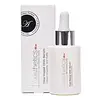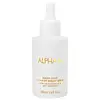What's inside
What's inside
 Key Ingredients
Key Ingredients

 Benefits
Benefits

 Concerns
Concerns

 Ingredients Side-by-side
Ingredients Side-by-side

Water
Skin ConditioningShea Butter Ethyl Esters
EmollientBrassica Glycerides
EmollientPropanediol
SolventButylene Glycol
HumectantGlyceryl Stearate Se
EmulsifyingBehenyl Alcohol
EmollientPhenoxyethanol
PreservativeGlycerin
HumectantPullulan
Hydrolyzed Hyaluronic Acid
HumectantButyrospermum Parkii Butter
Skin ConditioningSodium Hyaluronate
HumectantLecithin
EmollientSodium Acrylates Copolymer
Nannochloropsis Oculata Extract
HumectantHippophae Rhamnoides Fruit Oil
Skin ProtectingDisodium EDTA
Sodium Hydroxymethylglycinate
PreservativeRetinal
Skin ConditioningEthylhexylglycerin
Skin ConditioningLysolecithin
EmulsifyingSclerotium Gum
Emulsion StabilisingTocopherol
AntioxidantDimethylmethoxy Chromanol
AntioxidantXanthan Gum
EmulsifyingAcetyl Glutamine
Skin ConditioningGlycine Soja Oil
EmollientPotassium Sorbate
PreservativeSodium Benzoate
MaskingBacillus/Folic Acid Ferment Filtrate Extract
AntioxidantCaprylyl Glycol
Emollient1,2-Hexanediol
Skin ConditioningAcetyl Hexapeptide-51 Amide
Skin ConditioningSh-Oligopeptide-1
Skin ConditioningSh-Oligopeptide-2
Skin ConditioningSh-Polypeptide-1
Skin ConditioningSh-Polypeptide-9
Skin ConditioningSh-Polypeptide-11
Citric Acid
BufferingWater, Shea Butter Ethyl Esters, Brassica Glycerides, Propanediol, Butylene Glycol, Glyceryl Stearate Se, Behenyl Alcohol, Phenoxyethanol, Glycerin, Pullulan, Hydrolyzed Hyaluronic Acid, Butyrospermum Parkii Butter, Sodium Hyaluronate, Lecithin, Sodium Acrylates Copolymer, Nannochloropsis Oculata Extract, Hippophae Rhamnoides Fruit Oil, Disodium EDTA, Sodium Hydroxymethylglycinate, Retinal, Ethylhexylglycerin, Lysolecithin, Sclerotium Gum, Tocopherol, Dimethylmethoxy Chromanol, Xanthan Gum, Acetyl Glutamine, Glycine Soja Oil, Potassium Sorbate, Sodium Benzoate, Bacillus/Folic Acid Ferment Filtrate Extract, Caprylyl Glycol, 1,2-Hexanediol, Acetyl Hexapeptide-51 Amide, Sh-Oligopeptide-1, Sh-Oligopeptide-2, Sh-Polypeptide-1, Sh-Polypeptide-9, Sh-Polypeptide-11, Citric Acid
Water
Skin ConditioningGlycolic Acid 14%
BufferingGlycerin
HumectantButylene Glycol
HumectantPropanediol
SolventDicaprylyl Carbonate
EmollientDimethicone
EmollientPotassium Hydroxide
BufferingCetyl Alcohol
EmollientHydrolyzed Jojoba Esters
Skin ConditioningMethyl Gluceth-20
HumectantSodium Polyacryloyldimethyl Taurate
Emulsion StabilisingTocopherol
AntioxidantHelianthus Annuus Seed Oil
EmollientDimethyl Isosorbide
SolventPhenoxyethanol
PreservativeFerulic Acid
AntimicrobialGlyceryl Stearate
EmollientPEG-100 Stearate
Ammonium Glycyrrhizate
MaskingHibiscus Sabdariffa Flower Extract
Skin ConditioningCaprylyl Glycol
EmollientHydroxypinacolone Retinoate 1%
Skin ConditioningSodium Hyaluronate
HumectantUbiquinone
AntioxidantHippophae Rhamnoides Fruit Extract
Skin ConditioningCodonopsis Lanceolata Extract
AntioxidantEthylhexylglycerin
Skin ConditioningPalmitoyl Tripeptide-5
Skin ConditioningWater, Glycolic Acid 14%, Glycerin, Butylene Glycol, Propanediol, Dicaprylyl Carbonate, Dimethicone, Potassium Hydroxide, Cetyl Alcohol, Hydrolyzed Jojoba Esters, Methyl Gluceth-20, Sodium Polyacryloyldimethyl Taurate, Tocopherol, Helianthus Annuus Seed Oil, Dimethyl Isosorbide, Phenoxyethanol, Ferulic Acid, Glyceryl Stearate, PEG-100 Stearate, Ammonium Glycyrrhizate, Hibiscus Sabdariffa Flower Extract, Caprylyl Glycol, Hydroxypinacolone Retinoate 1%, Sodium Hyaluronate, Ubiquinone, Hippophae Rhamnoides Fruit Extract, Codonopsis Lanceolata Extract, Ethylhexylglycerin, Palmitoyl Tripeptide-5
Ingredients Explained
These ingredients are found in both products.
Ingredients higher up in an ingredient list are typically present in a larger amount.
Butylene Glycol (or BG) is used within cosmetic products for a few different reasons:
Overall, Butylene Glycol is a safe and well-rounded ingredient that works well with other ingredients.
Though this ingredient works well with most skin types, some people with sensitive skin may experience a reaction such as allergic rashes, closed comedones, or itchiness.
Learn more about Butylene GlycolCaprylyl Glycol is a humectant and emollient, meaning it attracts and preserves moisture.
It is a common ingredient in many products, especially those designed to hydrate skin. The primary benefits are retaining moisture, skin softening, and promoting a healthy skin barrier.
Though Caprylyl Glycol is an alcohol derived from fatty acids, it is not the kind that can dry out skin.
This ingredient is also used as a preservative to extend the life of products. It has slight antimicrobial properties.
Learn more about Caprylyl GlycolEthylhexylglycerin (we can't pronounce this either) is commonly used as a preservative and skin softener. It is derived from glyceryl.
You might see Ethylhexylglycerin often paired with other preservatives such as phenoxyethanol. Ethylhexylglycerin has been found to increase the effectiveness of these other preservatives.
Glycerin is already naturally found in your skin. It helps moisturize and protect your skin.
A study from 2016 found glycerin to be more effective as a humectant than AHAs and hyaluronic acid.
As a humectant, it helps the skin stay hydrated by pulling moisture to your skin. The low molecular weight of glycerin allows it to pull moisture into the deeper layers of your skin.
Hydrated skin improves your skin barrier; Your skin barrier helps protect against irritants and bacteria.
Glycerin has also been found to have antimicrobial and antiviral properties. Due to these properties, glycerin is often used in wound and burn treatments.
In cosmetics, glycerin is usually derived from plants such as soybean or palm. However, it can also be sourced from animals, such as tallow or animal fat.
This ingredient is organic, colorless, odorless, and non-toxic.
Glycerin is the name for this ingredient in American English. British English uses Glycerol/Glycerine.
Learn more about GlycerinPhenoxyethanol is a preservative that has germicide, antimicrobial, and aromatic properties. Studies show that phenoxyethanol can prevent microbial growth. By itself, it has a scent that is similar to that of a rose.
It's often used in formulations along with Caprylyl Glycol to preserve the shelf life of products.
Propanediol is an all-star ingredient. It softens, hydrates, and smooths the skin.
It’s often used to:
Propanediol is not likely to cause sensitivity and considered safe to use. It is derived from corn or petroleum with a clear color and no scent.
Learn more about PropanediolSodium Hyaluronate is hyaluronic acid's salt form. It is commonly derived from the sodium salt of hyaluronic acid.
Like hyaluronic acid, it is great at holding water and acts as a humectant. This makes it a great skin hydrating ingredient.
Sodium Hyaluronate is naturally occurring in our bodies and is mostly found in eye fluid and joints.
These are some other common types of Hyaluronic Acid:
Learn more about Sodium HyaluronateTocopherol (also known as Vitamin E) is a common antioxidant used to help protect the skin from free-radicals and strengthen the skin barrier. It's also fat soluble - this means our skin is great at absorbing it.
Vitamin E also helps keep your natural skin lipids healthy. Your lipid skin barrier naturally consists of lipids, ceramides, and fatty acids. Vitamin E offers extra protection for your skin’s lipid barrier, keeping your skin healthy and nourished.
Another benefit is a bit of UV protection. Vitamin E helps reduce the damage caused by UVB rays. (It should not replace your sunscreen). Combining it with Vitamin C can decrease sunburned cells and hyperpigmentation after UV exposure.
You might have noticed Vitamin E + C often paired together. This is because it is great at stabilizing Vitamin C. Using the two together helps increase the effectiveness of both ingredients.
There are often claims that Vitamin E can reduce/prevent scarring, but these claims haven't been confirmed by scientific research.
Learn more about TocopherolWater. It's the most common cosmetic ingredient of all. You'll usually see it at the top of ingredient lists, meaning that it makes up the largest part of the product.
So why is it so popular? Water most often acts as a solvent - this means that it helps dissolve other ingredients into the formulation.
You'll also recognize water as that liquid we all need to stay alive. If you see this, drink a glass of water. Stay hydrated!
Learn more about Water